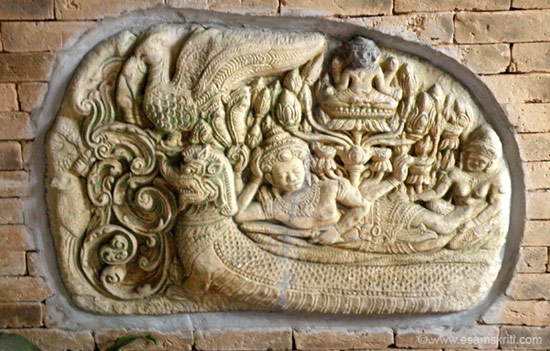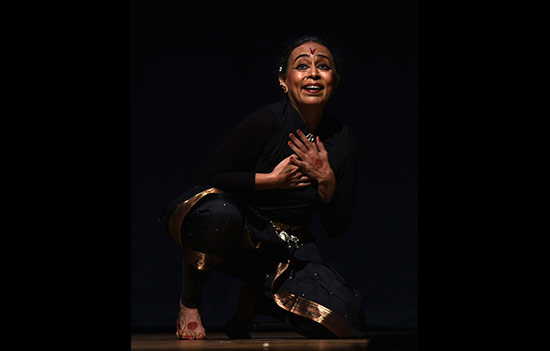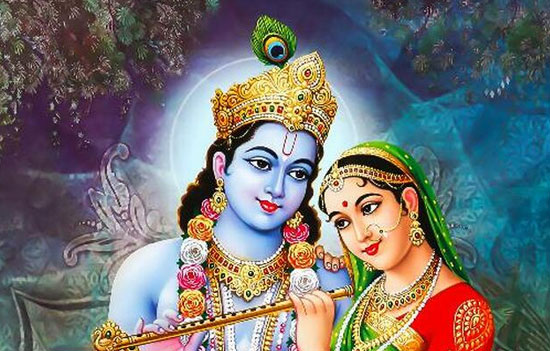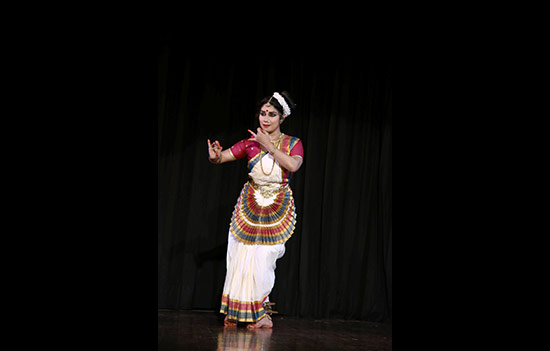- Know about the importance of Sri Krishna
in various dance forms namely Manipuri, Odissi and Mohiniattam (Kerala).
Indian classical dances are spiritually
deep rooted. A variety of stories from Hindu traditions are interpreted in all
the eight types of classical dances, whether it is Bharata Natyam, Mohiniattam,
Kathakali or Kathak. All classical dances portray the philosophy of reaching
out to the Supreme, through the dramatization and enaction of stories. In other
words it is the inter-relationship between the jeevatma (human soul) and parmatma
(Supreme Being) that is established in classical dance.
According to the Bhagvata Purana, Sri Krishna
is the eighth incarnation of Lord Vishnu, possibly the most favourite god to be
represented in all the classical dance styles of India. Commencing with his
birth to the finale of Geetoupedesham
in the battle of Kurukshetra, where he propagates and promotes the philosophy
of dharma, fighting against adharma in order to maintain righteousness,
peace and prosperity amidst people.
The complete charitram (story) of Sri Krishna is depicted based on songs,
composed and written by several scholars and lyricists for centuries together.
Before I refer to different classical dance styles, I would like to quote a
beautiful Sanskrit verse from the Bhagavata Purana, in praise of Lord Vishnu,
who forms the trinity of Indian classical dance, along with Lord Shiva and Lord
Brahma.
Shantakaram
Bhujagashayanam, Padbanabham Suresham, Viswadharam, Gagana shadrishyam.
Meghavarnam Shubhangam, Lakshmikantam, Kamalanayanam, Yogibrildhyan Gamyam,
Vande Visnhu Bhava bhaya Haram, Sarva Lokaika Natham
Translated as, “Obeisance to Vishnu, the dispeller of the fear of rebirths, the one Lord of all the regions, possessed of a tranquil form, lying on a bed of snake (shesh naag), from whose navel has sprung the lotus, the Lord of all celestials, the support of the universe, similar to the sky, possessed of the colour of the cloud and possessed of handsome limbs, the Lord of Lakshmi (the goddess of wealth), having lotus like eyes realized by Yogis in, meditation.”
 Shesh Naag form of Vishnu at Chiang Ma restaurant, Thailand. 2009.
Shesh Naag form of Vishnu at Chiang Ma restaurant, Thailand. 2009.
Jayadeva’s Geet Govind in Odissi
Odissi was danced primarily by the Maharis
(women dancers dedicated to the lord) in the temple of Jagannath at Puri. They
would dance only to instrumental music. It is believed that the tradition of
vocal accompaniment to dance started with the Geeta Govinda of Jayadev. He wrote
and composed this lyrical epic in the precincts of the temple at Puri, in the
12th century.
Geeta Govinda is a hymn to Sri Krishna, which
was to be sung and danced only for the Lord in the temple, not for the favor of
any royal patron. Thus the theme of Krishna came into Odissi dance through the
Geeta Govinda. It is noteworthy that the entire work was written and composed
only for dance, and from his time till today, it is a favourite with Odissi
dancers.
 Happy to see Lord Vitthal. Artist Jhelum Paranjpee.
Happy to see Lord Vitthal. Artist Jhelum Paranjpee.
Accomplished Odissi exponent Jhelum Paranjape says, “Geeta Govind concentrates on Krishna’s love with and for Radha. Intense earthly passion is the example Jayadeva uses, to express the complexities of divine and human love through the interpretation of varied astapadis (lyrical verses).”
As described in Geet Govind and other texts, Krishna's love is for everyone, including all the Gopis but Radha is the most intimate, as Krishna spends most of the time with Radha. She symbolises human love and Krishna is the divine love, their love is inseparable and unique, thereby Krishna is eternally remembered and worshipped as Radhe Krishna.
 Sri Krishna with Gopis. Manipuri Rasleela dance. Sangai Festival 2014.
Sri Krishna with Gopis. Manipuri Rasleela dance. Sangai Festival 2014.
It is interesting to note that some of the
ashtapadis describe that Krishna is
depressed and feeling lonely, due to the absence of Radha, which is rarely
depicted or observed in classical dance. Normally it is heroines who are always
suffering from the pangs of separation (viraha
tapam). Abhinaya entered the
dance of the Maharis with Geeta
Govind. This dance of the Maharis (devadasis) combined with the dance of the Gotipuas later came to be called Odissi.
Odissi dance enriched itself further in abhinaya with the theme of Radha and
Krishna with this class of dancers known as Gotipuas-young
boy dancers dressed in female attire. When the dance of the Maharis slowly
declined due to various reasons, this class of boy dancers was created to carry
on the tradition. During this period Vaishnav poets wrote and composed
innumerable lyrics in dedication to Sri Krishna, describing his valor and his
dalliance with Radha etc. The Vaishnavs chose this dance of the Gotipuas as a
medium to popularize of their philosophy.
 Krishna and Radha.
Krishna and Radha.
The Krishna theme has become the core of
the abhinaya portrayed in Odissi
dance. Beginning from the time of Geeta Govinda and the Odiya songs till date,
where now the Krishna theme peeps into Odissi dance, through various other
languages. The Odiya songs are written by a large number of Vaishnav poets.
The three that dominate the Odissi dance scene are Kavisurya Baladev Rath, Gopalkrishna Pattanaik and Banamali Das. The Odiya songs of these poets are nothing but the regional language counter parts of the Geeta Govinda. Mind you, these are translations…it’s the same thought and philosophy that’s underlined.
Also
read
Jayadeva’s Gita Govinda and About
Jayadeva
Narayaneeyam by Narayana Bhattiripad
Narayaneeyam by Narayana Bhattiripad is a
16th century Sanskrit classic that describes the complete life story
of Sri Krishna as Guruvayurappan.
It is interesting to narrate here that
Narayana Bhattiripad was a great devotee of Sri Krishna and would sing praises of
the Lord. It was his great desire to interpret the verses in a poetic format. Suffering
from rheumatism he could hardly move or write but his ardent devotion induced
him to write the complete story of Sri Krishna. Surprisingly, slowly and
steadily all his illness disappeared after he completed the immortal classic
Narayaneeyam. Renonwed Mohiniattam exponent Dr Geeta Radhakrishna has
choreographed Narayaneeyam in Mohiniattam and has rendered several shows in
India and abroad.
 Krishna holding the flute. Performance by Mythili Anoop.
Krishna holding the flute. Performance by Mythili Anoop.
Young and brilliant Mohiniattam exponent Mythili Anoop says “There has been a tradition of singing astapadis from Gita Govinda in the Sopanam style, by a musician, in
many temples of Kerala, who also played the edakka.
The rendition is in the Keralite Sopana
Sampradayaam. This singing can be heard in many temples even today such as Guruvayoor Temple.”
Swathi Thirunal's kritis which are part of the traditional Mohiniyattam repertoire,
refer to Krishna. The famous varnam, Sumasaayaka, is an address by the sakhi to Madhava, telling him to pay heed to her friend's languishing state in his absence. Tha padam, Karuna
Cheyvaan enthu... (“Why the delay in showing mercy” composed by Irayimman Thambi is also part of the Mohiniyattam repertoire. There are several dancers who have composed the Bhajans of Swathi Thirunal such as Chaliye Kunjanamo, Aaj Aaye
Shyam Mohan and Jamuna Kinare.
The kathakali Padam, Ajitha Hare Jaya
Madhava has also been composed in Mohiniyattam in which the episode of Krishna's revelation of his true form to Arjuna in the midst of the battlefield is enacted.
Just as in the other classical dance
forms, the ashtapadis have also been
composed in Mohiniyattam. Further, contemporary poetry on Krishna has been
composed by artists such as Padmasri Kalamandalam Kshemavathy and SNA Awardee,
Gopika Varma. Guru Nirmala Panikker has written and composed a varnam on
Krishna, bringing in the Dashavataaras as well in Geetamodhiya Govindan. Kalamandalam Kshemavathy has a new varnam in
her repertoire based on the story of Manjula, the devotee of Krishna at the
Guruvayoor temple in Saramati Raagam, Guru
pavanapure.”
Sadanam Balakrishnan, The SNA Awardee and
Kathakali maestro has written, choreographed and presented Radha Madhavam which is based on the idea of the eternal and transcendental
love between Radha and Krishna. The production has been presented as a jugalbandhi between Kathakali and
Mohiniyattam on many stages.
Thus, Sri Krishna worship in the form of
dance is seen in states of Manipur, Odisha (east India) and Kerala (south
India) amongst others. Various stories of Krishna are portrayed in Kathakali
too with dramatic exposition of the story.
In order to experience divine bliss or anandam, one should surrender completely
to the lotus feet of the Almighty, with complete devotion and reverence to
achieve moksham or enlightenment.
Guru Vijay Shanker is
a professional Kuchipudi, Kathakali exponent, dance teacher,
choreographer, actor and arts critic for over four decades, contributing for
national and international publications. He is particularly credited for his
lecture-demonstrations on Indian classical dancing which is a fine combination
of both education and entertainment.
To read all
articles by author
To read all articles on
Indian Classical Dance
Also
read
1. Odissi
is an elegant Indian Dance Form
2. Mohiniattam – dance of the Enchantress